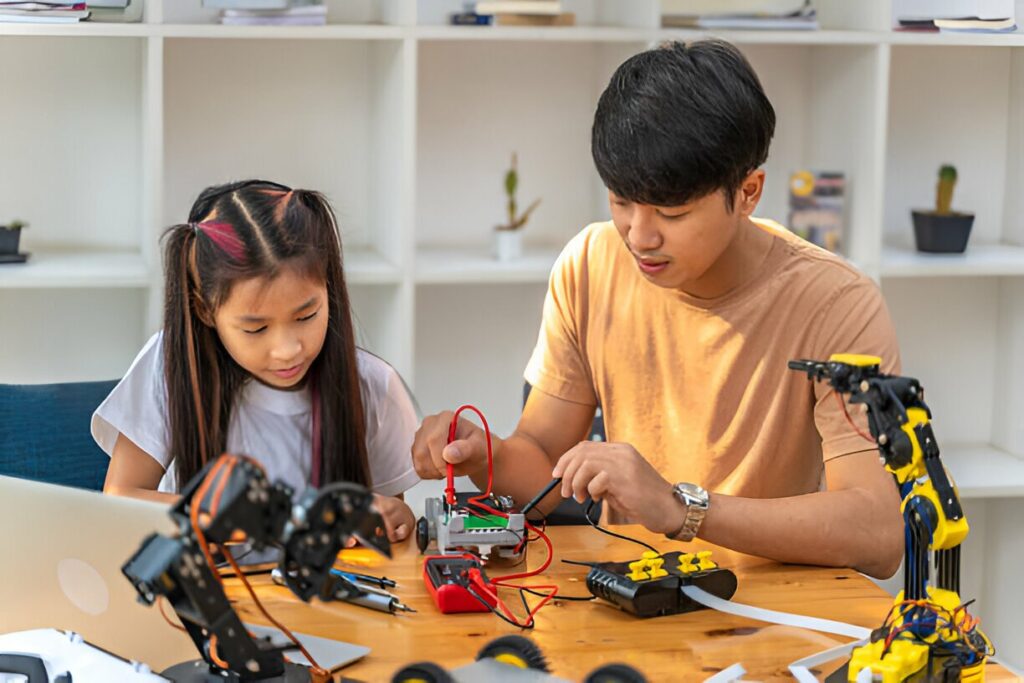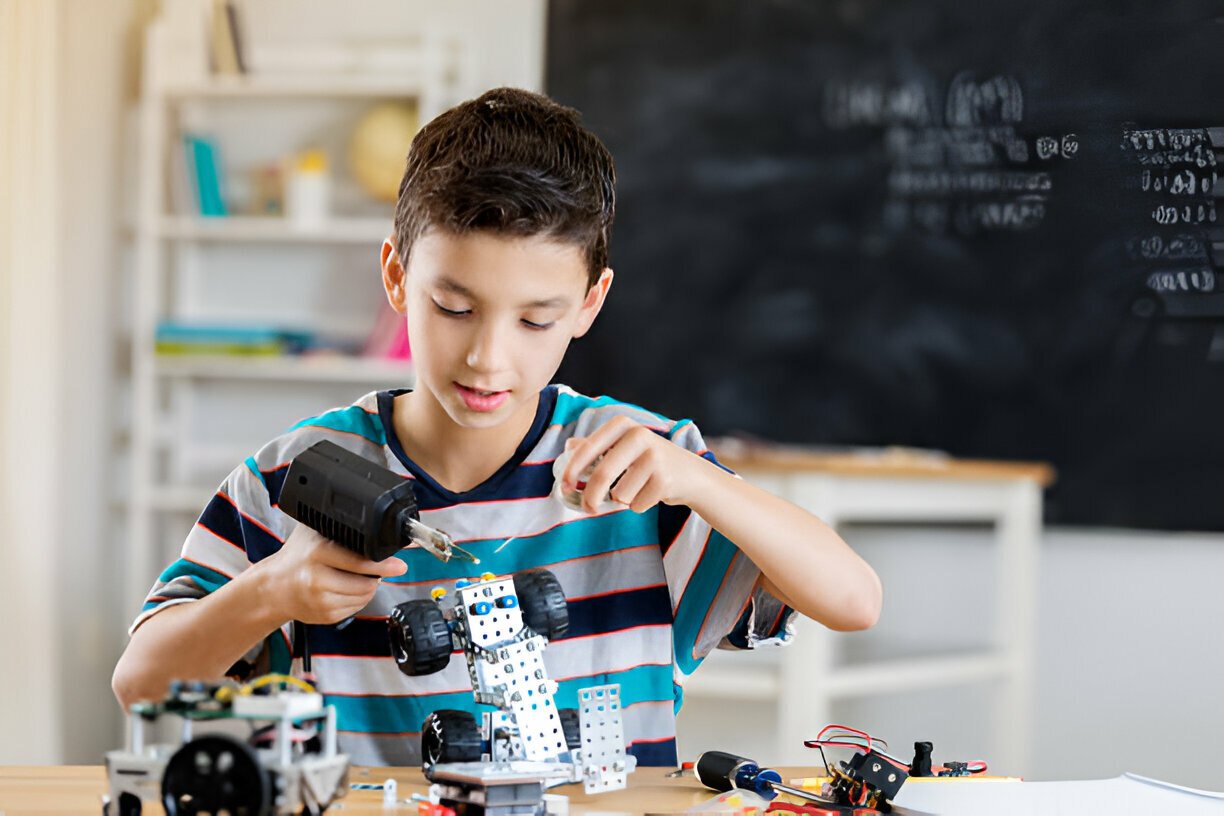In the ever-changing world of education, mastering discipline in STEM (Science, Technology, Engineering, and Mathematics) has become essential for progressive teaching. It’s where innovation meets traditional teaching methods. Stressing the importance of discipline in STEM education not only shapes students’ academic growth but also develops their problem-solving skills.
STEM teachers need practical problem-solving examples to effectively teach their students. As educators, having concrete examples allows us to explain complex ideas more simply. This helps spark students’ curiosity and supports them in becoming better problem solvers.
This article is a comprehensive guide for teachers navigating the wide field of STEM education. It focuses on discipline and problem-solving, exploring different frameworks and principles that make STEM teaching effective. We’ll cover strategies to boost motivation and self-perception in students, talk about the role of scientific inquiry and the engineering design process, and examine how using real-world situations can enhance STEM teaching.
Additionally, we’ll provide:
1. Practical examples for primary school level STEM education
2. Innovative ways to incorporate technology into teaching, specifically using chatbots for mathematics instruction
3. The importance of continuous professional development in improving STEM teaching practices
Join us as we explore how to master discipline through practical problem-solving in STEM education. Feel free to use the strategies and resources shared here to enhance your approach to teaching STEM subjects.
Understanding STEM Education
STEM education, a blend of Science, Technology, Engineering, and Mathematics, is not as straightforward as teaching these disciplines in isolation. The material Steam and Corso stem involves integrating these subjects in a way that helps students understand their interdependence and their relevance to the world beyond the classroom. The approach is crucial in light of the 21st-century environmental impacts and social issues we face today.
Challenges in STEM Education
A lack of cohesive understanding among educators often compounds the challenge of imparting high-quality STEM education. Teachers need to be on the same page about the goals and methodologies of STEM education.
Environmental Impact
Climate change, resource depletion, and biodiversity loss are some of the pressing environmental issues that underscore the urgency to improve STEM education. Students equipped with a robust STEM foundation will be better prepared to understand these complex problems and devise innovative solutions.
Social Impact
Rapid technological advancements are reshaping society and our day-to-day lives. From artificial intelligence to biotechnology, STEM education can help students navigate this rapidly changing landscape.
Global Factors
Geopolitical tensions, economic disparities, and cultural differences add layers of complexity to STEM education. These global factors necessitate an adaptable and globally aware approach to teaching STEM.
Cohesion Among Educators

A common challenge in implementing effective STEM education is the lack of cohesive understanding among educators. This fragmentation can lead to discrepancies in teaching methods and learning outcomes. It’s essential to foster a shared understanding and alignment among educators about the core principles and objectives of Didattica Steam.
Building a coherent framework for STEM instruction involves several key steps:
1. Define clear learning objectives for each STEM discipline
2. Establish interdisciplinary links between different subjects
3. Incorporate real-world applications and problem-solving strategies
4. Foster an environment that encourages creativity, collaboration, critical thinking, and communication
In essence, mastering discipline in STEM education involves understanding the complexities of the subjects and their interconnections, appreciating the urgency of addressing environmental and social challenges, and fostering greater cohesion among educators in implementing effective teaching strategies.
Integrated STEM Education Framework
STEM education is more than just combining science, technology, engineering, and mathematics subjects. It requires an interdisciplinary approach that reflects real-world situations. Here are the key aspects of an integrated STEM education framework:
Blended Learning Theories
Traditional learning theories like constructivism and behaviorism are combined with 21st-century approaches to support a STEM framework. This combination encourages dynamic learning, where students actively build knowledge through hands-on experiences and digital tools.
Operationalizing Key Concepts
Mastering abstract concepts in STEM requires turning them into tangible learning experiences. Integrated STEM achieves this by translating theoretical ideas into practical activities and experiments that make complex principles clear.
Rigorous Curriculum
A strong curriculum is essential for high-quality STEM education. It should include the following elements:
● In-depth content to challenge students’ understanding
● Coverage of various disciplines to show how they are connected
● Development of skills that match students’ cognitive growth
The curriculum should also address environmental issues of the 21st century, preparing students to solve urgent global problems with innovative ideas.
Role of Interdisciplinary Approach
By combining different subjects, educators help students develop a unified understanding. This approach teaches students to look at problems from multiple angles, giving them a well-rounded education that prepares them for future challenges.
By incorporating these elements into their teaching, STEM educators can effectively involve students in a complete learning experience that strengthens their knowledge in specific subjects while sharpening their problem-solving abilities.
Principles of Human Learning in STEM Education

STEM education is based on several principles of human learning. These principles guide the curriculum, instruction, assessment, and professional development in STEM education.
Motivation and Self-perception in Learning
One of the main principles of human learning is the role of motivation and self-perception. Learners’ motivation and self-perception significantly affect learning outcomes and effort. Students who are motivated and see themselves as capable learners tend to put more effort into their learning process. This leads to better results compared to their less motivated peers.
Motivation can be intrinsic or extrinsic. Intrinsic motivation comes from the joy and satisfaction derived from learning itself. Learners with high intrinsic motivation have a natural curiosity and interest in acquiring new knowledge. On the other hand, extrinsic motivation refers to the desire to achieve specific outcomes, such as good grades or rewards.
Self-perception also plays a crucial role in learning. A student’s belief about their abilities can greatly influence their motivation, learning behavior, and academic achievement.
Strategies to Enhance Motivation in STEM Education
Engaging students’ interests is essential for enhancing motivation in STEM education. Here are some practical strategies:
1. Relevance: Make sure that the lessons are relevant to the students’ lives. Connect classroom teaching with real-world applications.
2. Challenge: Present tasks that are challenging but achievable with effort and persistence.
3. Choice: Allow students to have a choice in selecting tasks or projects. This empowers them and boosts their motivation.
4. Feedback: Provide timely, constructive feedback that aids students in understanding how they can improve.
Promoting positive self-perceptions is equally important. Teachers can boost students’ self-esteem by:
● setting realistic expectations
● promoting a growth mindset
● recognizing effort rather than innate ability
● encouraging peer support
Understanding these principles provides a foundation for developing effective teaching strategies in STEM education. It allows for the creation of a learning environment that:
● fosters motivation
● promotes positive self-perceptions
● ultimately improves student outcomes.
Promoting Scientific Inquiry and Engineering Design Process
Scientific inquiry and the engineering design process play a crucial role in STEM education. They help organize knowledge around key concepts and principles of the subject.
Scientific Inquiry in STEM Education
Scientific inquiry involves students using what they already know to learn new things. It encourages them to ask questions, make predictions, gather data, and draw conclusions. This approach is essential for developing a deeper understanding of scientific concepts.
The Engineering Design Process in STEM Education
The engineering design process is a series of steps that engineers follow to find solutions to problems. It can also be applied in STEM education to encourage students’ creativity and problem-solving abilities. The steps include:
1. Defining the problem
2. Brainstorming possible solutions
3. Designing and building a prototype
4. Testing the prototype
5. Making improvements based on test results (iteration)
Strategies for Integrating Inquiry-Based Instruction in STEM Teaching
Here are some effective ways to incorporate inquiry-based instruction into your STEM lessons:
1. Problem-Based Learning: Present students with real-world problems and guide them through the process of finding solutions. This strategy helps improve their problem-solving skills and critical thinking abilities.
2. Project-Based Learning: Encourage students to work on projects that require them to apply various STEM concepts. This approach promotes creativity and innovation.
3. Collaborative Learning: Facilitate group activities where students work together to solve complex tasks. This method enhances their communication skills and ability to work as a team.
The Importance of Motivation in STEM Education
It’s important to remember that motivation plays a significant role in students’ learning outcomes and effort. To keep your lessons engaging and meaningful, consider these tips:
● Relate the content to real-life situations or issues that students can connect with.
● Provide opportunities for hands-on learning and experimentation.
● Use technology and multimedia resources to make lessons more interactive.
● Offer praise and recognition for students’ efforts and achievements.
Benefits of Promoting Scientific Inquiry and the Engineering Design Process
By incorporating scientific inquiry and the engineering design process into your STEM teaching, you can help students:
1. Develop a deeper understanding of key concepts and principles in science, technology, engineering, and mathematics.
2. Enhance their critical thinking, problem-solving, and creativity skills.
3. Improve their ability to work effectively in teams and communicate their ideas.
4. Gain practical experience in applying STEM knowledge to real-world situations.
These skills are highly valued in today’s job market and are essential for success in the 21st-century workforce.
Authentic Contexts in Integrating STEM Education

Integrating science, technology, engineering, and mathematics in authentic contexts is vital for enabling students to connect classroom learning with real-world applications. Authentic contexts in STEM education mean presenting problems and projects that reflect the complexity and ambiguity of real-life scenarios. This approach not only engages students more deeply but also prepares them for future challenges by:
● Allowing them to apply theoretical knowledge to practical situations
● Encouraging the development of critical thinking and problem-solving skills
● Enhancing collaboration as they work through complex issues with peers
When students structure content knowledge around discipline principles, they gain a deeper understanding of the subject matter. This process is known as situated STEM learning, where learning occurs within the context it will be used. It promotes long-term retention of knowledge and skills because students see the relevance to their own lives and future careers.
Technological literacy in STEM education is no longer optional; it’s a necessity. As technology permeates every aspect of modern life, providing students with the skills to navigate and innovate within this space becomes crucial. Technological literacy involves:
● Understanding how technological systems work
● Being able to use, manage, and evaluate technology effectively
● Developing an appreciation for the impact of technology on society and the environment
Role of Teacher’s Content Knowledge in STEM Teaching
The teacher’s content knowledge stands as a cornerstone in successful STEM teaching. The depth and breadth of a teacher’s understanding directly influence their ability to deliver complex concepts clearly and effectively. Strong content knowledge allows teachers to:
● Anticipate student misconceptions
● Tailor instruction to meet diverse needs
● Provide detailed explanations and inventive examples that resonate with learners
Domain pedagogical content knowledge goes beyond general teaching strategies; it merges subject expertise with pedagogy tailored to that specific domain. Ineffective STEM instruction, this specialized knowledge enables educators to:
● Design activities that address both content standards and process skills
● Choose appropriate instructional tools and resources
● Assess student understanding accurately through various methods
By nurturing these competencies, educators create enriching environments where students can thrive as they grapple with genuine scientific questions and engineering challenges.
Providing Practical Problem-Solving Examples for STEM Teachers
STEM education thrives on real-world applications that ignite student curiosity and problem-solving skills. Teachers in this field must harness practical examples to effectively impart crucial concepts. By integrating hands-on activities, educators enhance learning experiences, making abstract principles tangible and engaging.
Activities for Primary School Level STEM Education:
Biomechanics of Animals:
○ Students design and build simple models of animal legs using craft materials.
○ They explore how different limb structures affect movement.
Solar System Scale Model:
○ Pupils create a scale model of the solar system with paper and markers.
○ This activity emphasizes spatial reasoning and astronomical distances.
Water Filtration Experiment:
○ Classroom groups design water filters using natural materials.
○ A vivid demonstration of environmental science and sustainability.
Coding Basic Animations:
○ Utilizing simple block-based coding platforms to animate stories.
○ Fosters logical thinking and introduces basic programming concepts.
Bridge Building Challenge:
○ Use straws or popsicle sticks to construct bridges that can bear weight.
○ Introduces principles of engineering and material strength.
By embedding these practical STEM activities into lesson plans, teachers enable students to grapple with real challenges and develop invaluable critical thinking abilities. Focusing on activities that are suitable for primary school students, such initiatives cater to young minds’ innate curiosity and their propensity for kinesthetic learning. These examples serve as a starting point for students to apply STEM principles creatively and collaboratively, setting a foundation for advanced problem-solving skills as they progress in their educational journey.
Utilizing Technology: The Role of Chatbots in Teaching Mathematics
STEM education recognizes the importance of technology integration. A prime example is the use of chatbots for teaching and learning mathematics, especially at the primary school level.
Chatbots like Chat GPT Matematica serve as virtual tutors, guiding students through mathematical problems and providing instant feedback. These AI-powered tools adapt to each student’s learning pace, encouraging incremental progress and boosting self-confidence.
Key benefits of using chatbots include:
● Personalized Learning: Chatbots can tailor instructions and exercises to individual learning styles and abilities.
● Instant Feedback: Students get immediate responses to their queries or solutions, facilitating real-time learning.
● Engagement: The interactive nature of chatbots enhances student engagement and motivation.
To harness the power of technology in STEM instruction, platforms like Steam Scuola Primaria offer an array of resources. To get started:
1. Register on the Steam Piattaforma.
2. Browse through diverse educational games and software tailored for different age groups.
3. Choose relevant applications that align with your teaching goals.
Integrating technology into STEM education not only equips students with necessary 21st-century skills but also makes learning more engaging and enjoyable.
Continuous Professional Development in STEM Education
Continuous professional development is crucial for improving STEM teaching practices. As educators adapt to the changing landscape of STEM education, they understand the significance of exploring new teaching methods and educational technologies.
A recommended resource for educators looking to enhance their skills is a comprehensive online math course. This type of course offers:
● Innovative Teaching Strategies: Interactive modules that introduce dynamic ways to engage students in mathematics.
● Curriculum Design: Guidance on integrating cutting-edge STEM content into lesson plans.
● Assessment Tools: Methods for evaluating student progress using technology-enhanced techniques.
● Collaborative Opportunities: Forums for discussion and sharing best practices with fellow educators.
Choosing an online math course that aligns with your teaching goals can boost your professional development and directly improve your effectiveness in the classroom. By committing to continuous learning, you ensure that your teaching methods remain current and motivating for your students.
For STEM educators, the pursuit of knowledge never stops. Embrace the journey through ongoing professional development, and see how it transforms both your teaching and your students’ learning experiences.
Engaging STEM Activities: Practical Examples for Primary School Teachers
1. Biomechanics of Animals (Primary School Level)
- Activity Description: Students design and build models of animal legs using craft materials like straws, clay, and rubber bands. They explore how different limb structures affect movement and adapt to environments.
- Learning Outcome: This activity introduces students to basic concepts of biomechanics and engineering, encouraging them to think about how structure influences function in both animals and engineered systems.
2. Solar System Scale Model (Primary School Level)
- Activity Description: Pupils create a scale model of the solar system using beads for planets and string to measure out distances between them on a scale. This can be laid out across the schoolyard to provide physical representation of space.
- Learning Outcome: Students learn about the vast distances in our solar system, reinforcing spatial reasoning and scale, and introducing astronomical concepts in a tangible way.
3. Water Filtration Experiment (Primary School Level)
- Activity Description: Classroom groups design and build water filters using natural materials like sand, pebbles, and cotton to clean dirty water. This experiment can also include a discussion on water pollution and sustainability.
- Learning Outcome: This vivid demonstration integrates environmental science and chemistry, showing students the importance of clean water and the basics of how filtration works.
4. Coding Basic Animations (Primary School Level)
- Activity Description: Using block-based coding platforms like Scratch, students create simple animations or stories. This activity can be theme-based, like creating a short story about a journey through the solar system.
- Learning Outcome: Fosters logical thinking and problem-solving skills while introducing basic programming concepts and digital literacy.
5. Bridge Building Challenge (Primary School Level)
- Activity Description: Students use straws, popsicle sticks, or other craft materials to construct a bridge that can hold a specific weight. This challenge can be structured as a competition to see which bridge holds the most weight.
- Learning Outcome: Introduces students to basic principles of engineering and material strength, encouraging them to experiment with design and structure.
Integrating Technology: The Role of Chatbots in Teaching Mathematics
- quations or geometry problems by guiding them through each step of the problem-solving process, offering hints and explanations.
- Benefits: Provides personalized learning which adapulates to the student’s pace, encourages self-driven learning, and makes mathematics more engaging.
Continuous Professional Development
- Example Resource: An online course on innovative STEM teaching strategies, featuring modules on integrating technology in the classroom, designing interdisciplinary STEM curricula, and using digital assessment tools.
- Impact: Empowers teachers to stay updated on the latest educational technologies and teaching methodologies, enhancing their instructional skills and effectiveness.
Conclusion
Mastering discipline in STEM education, especially with a STEAM approach, is an ongoing and ever-changing journey. As educators, you have a variety of practical problem-solving examples to help you navigate the complexities of teaching these crucial subjects. It’s essential to embrace these tools and strategies to create environments where students can excel in science, technology, engineering, arts, and mathematics.
Here are some key takeaways from this discussion:
● Recognize the transformative power of practical problem-solving examples as catalysts for student engagement.
● Utilize the available resources and methods to strengthen your teaching approach.
● Challenge students with real-world problems, motivating them to apply their knowledge in creative and effective ways.
The commitment to continuously improve STEM education is evident in the effort to incorporate innovative teaching methods. We encourage you to use the insights from this conversation wisely, using them as inspiration to educate future generations. By doing so, you play a significant role in preparing a skilled workforce capable of tackling tomorrow’s challenges.

